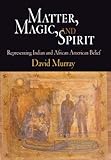Matter, Magic, and Spirit : Representing Indian and African American Belief / David Murray.
Material type: TextPublisher: Philadelphia : University of Pennsylvania Press, [2013]Copyright date: ©2007Description: 1 online resource (224 p.)Content type:
TextPublisher: Philadelphia : University of Pennsylvania Press, [2013]Copyright date: ©2007Description: 1 online resource (224 p.)Content type: - 9780812239966
- 9780812202878
- 200.89/96073
- online - DeGruyter
- Issued also in print.
| Item type | Current library | Call number | URL | Status | Notes | Barcode | |
|---|---|---|---|---|---|---|---|
 eBook
eBook
|
Biblioteca "Angelicum" Pont. Univ. S.Tommaso d'Aquino Nuvola online | online - DeGruyter (Browse shelf(Opens below)) | Online access | Not for loan (Accesso limitato) | Accesso per gli utenti autorizzati / Access for authorized users | (dgr)9780812202878 |
Browsing Biblioteca "Angelicum" Pont. Univ. S.Tommaso d'Aquino shelves, Shelving location: Nuvola online Close shelf browser (Hides shelf browser)

|

|

|

|

|

|

|
||
| online - DeGruyter Liberia : The Violence of Democracy / | online - DeGruyter Inherent Human Rights : Philosophical Roots of the Universal Declaration / | online - DeGruyter Lives of the Anchoresses : The Rise of the Urban Recluse in Medieval Europe / | online - DeGruyter Matter, Magic, and Spirit : Representing Indian and African American Belief / | online - DeGruyter First City : Philadelphia and the Forging of Historical Memory / | online - DeGruyter Defining the Sovereign Community : The Czech and Slovak Republics / | online - DeGruyter God and the Goddesses : Vision, Poetry, and Belief in the Middle Ages / |
Frontmatter -- Contents -- Introduction -- Chapter 1. Hierarchies of Race and Religion: Fetishism, Totemism, Manitou, and Conjure -- Chapter 2. Superstition and Progress -- Chapter 3. Primitivism, Modernism, and Magic -- Chapter 4. Black Arts: Conjure and Spirit -- Chapter 5. The Return of the Fetish -- Notes -- Bibliography -- Index -- Acknowledgments
restricted access online access with authorization star
http://purl.org/coar/access_right/c_16ec
The spiritual and religious beliefs and practices of Native Americans and African Americans have long been sources of fascination and curiosity, owing to their marked difference from the religious traditions of white writers and researchers. Matter, Magic, and Spirit explores the ways religious and magical beliefs of Native Americans and African Americans have been represented in a range of discourses including anthropology, comparative religion, and literature. Though these beliefs were widely dismissed as primitive superstition and inferior to "higher" religions like Christianity, distinctions were still made between the supposed spiritual capacities of the different groups.David Murray's analysis is unique in bringing together Indian and African beliefs and their representations. First tracing the development of European ideas about both African fetishism and Native American "primitive belief," he goes on to explore the ways in which the hierarchies of race created by white Europeans coincided with hierarchies of religion as expressed in the developing study of comparative religion and folklore through the nineteenth century. Crucially this comparative approach to practices that were dismissed as conjure or black magic or Indian "medicine" points as well to the importance of their cultural and political roles in their own communities at times of destructive change.Murray also explores the ways in which Indian and African writers later reformulated the models developed by white observers, as demonstrated through the work of Charles Chesnutt and Simon Pokagon and then in the later conjunctions of modernism and ethnography in the 1920s and 1930s, through the work of Zora Neale Hurston, Zitkala Sa, and others. Later sections demonstrate how contemporary writers including Ishmael Reed and Leslie Silko deal with the revaluation of traditional beliefs as spiritual resources against a background of New Age spirituality and postmodern conceptions of racial and ethnic identity.
Issued also in print.
Mode of access: Internet via World Wide Web.
In English.
Description based on online resource; title from PDF title page (publisher's Web site, viewed 24. Apr 2022)


